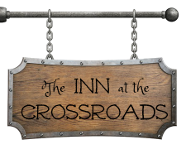
Thoughts:
I’ve had a few inquiries since the cookbook came out about the beautiful and mouthwatering crown roast on the front cover. No wonder, since it’s so striking: (photo) However, I have a secret to confess. Until now, there was no recipe to go with that dish, either in the cookbook or on the blog. Finally, I’ve decided to fix that. When Sariann and I went to do the cover photo shoot, we had to make a lot of food. Like, a few days’ worth of cooking; We didn’t know what would get used, so we brought a bit of everything. I had hoped to bring a version of the rack of lamb with garlic/herb crust, but lamb was just too expensive for a dish that might not get eaten after hours under photography lights. If I buy lamb, I want to eat every last bit of it. So I bought a rack of beef ribs much more inexpensively, and trimmed them to look fancy. It worked, but leaves me hungry every time I look at the cookbook. Thus, this new suggestion for a future aSoIaF book- the crown roast.
While the cookbook cover roast was predominantly for show, this version begs to be eaten. The bacon around the bottom keeps it juicy and delicious, while the stuffing finishes cooking to be dense and filling. The meat pulls flavor from the bacon on the outside and the stuffing on the inside. While the meat wasn’t quite fall-off-the-bone tender, it was pretty close.
Why it should be in the next book:
It’s a crown. Made of meat. Wrapped in bacon. Tell me that some witty Westerosi cook wouldn’t serve something like this at, say, a coronation feast. It’s also a perfect centerpiece for your S4 premiere parties, because who doesn’t love gnawing on a bone at a medieval feast? (vegetarians excepted…)
Crown Roast Recipe
Time: ~2 hours Serves: depends on the size! figure 2-3 ribs per person, with additional sides
Ingredients:
- 1 rack of ribs, your choice of meat (I used pork)
- salt and pepper
- Stuffing (get the recipe)
- ~5 strips of Bacon
French the ribs, if your butcher can’t/won’t. Do this by trimming down the meat around the tops of the ribs to leave about an inch of exposed bone. This is just to make it look fancier, like in the picture, but if you’re pressed for time, you could skip it. Save the trimmed bits of meat, taking care to check each for small pieces of bone. Curve the trimmed rack around on itself so the rib ends are pointing up and out, then secure the two ends together with a bit of twine or toothpicks (if you use toothpicks, remember to warn guests before serving).
Wrap two or three strips of bacon around the bottom of the crown roast. Fry the remaining bacon, dry, and crumble into the stuffing. Brown the leftover bits of trimmed meat from the top of the roast in the bacon fat, then add it to the stuffing mixture. Press the stuffing into the middle of the crown. Cover the stuffing with tin foil, and cook the roast at 375 for around 2 hours. If you like, remove the foil about 20 minutes from the end of cooking to allow it to brown.
To serve, cut into small rib sections, and dish up with some of the stuffing. If you like have a little of your favorite sauce available on the side.






















